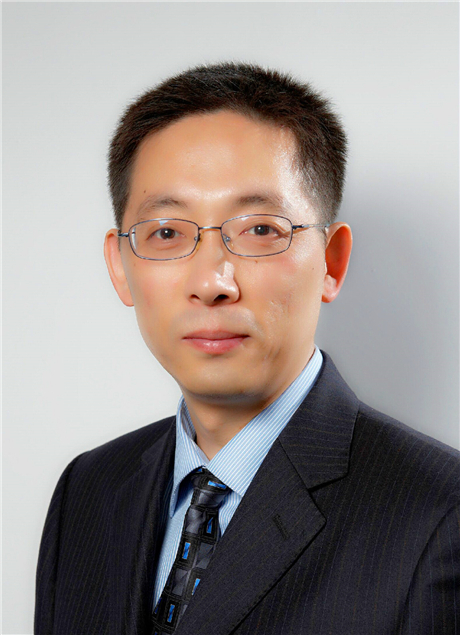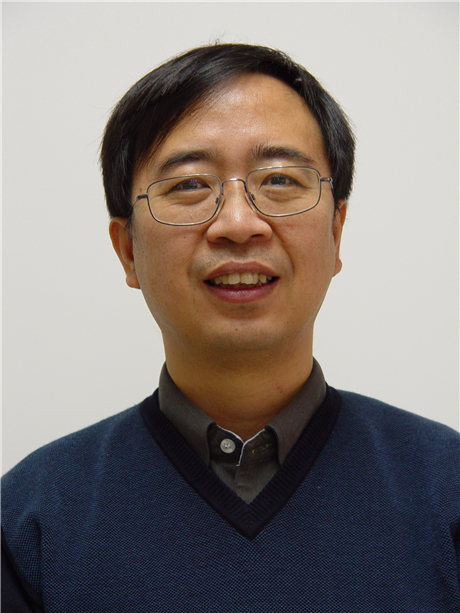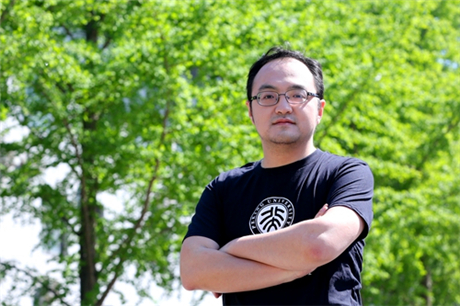Announcement of 2017 Future Science Prize
Winners: Yigong Shi, Jianwei Pan, Chenyang Xu
The winners for the 2017 Future Science Prize are announced in Beijing on September 9, 2017. Yigong Shi won the Prize in life sciences for his elucidation of high-resolution structures of the eukaryotic spliceosome, revealing the active-site and the molecular-level mechanism of this key complex in mRNA maturation. Jianwei Pan won the Future Science Prize in physical sciences for his innovative contributions to quantum optical technology, enabling practical implementation of secure communication through quantum key distribution. Chenyang Xu won the prize in mathematics and computer science, introduced this year, for his fundamental contributions to birational algebraic geometry.
Dr.Shi’s elucidation of high-resolution structures of the eukaryotic spliceosome, revealing the active-site and the molecular-level mechanism of this key complex in mRNA maturation.
In the central dogma of molecular biology, genetic information flows from DNA to RNA and then to protein. All eukaryotic organisms from yeast to humans contain genes that consist of exons—DNA sequences that code protein information, and introns—DNA sequences that do not code protein information. After transcribed from DNA, non-coding introns must be removed from precursor messenger RNA (pre-mRNA) by the spliceosome complex, so that mature mRNA can be subsequently translated into protein. Disruptions of RNA splicing are known to cause many human genetic disorders. However, the near-atomic resolution structure of the spliceosome, the dynamic molecular machine that mediates RNA splicing, had never been elucidated prior to Dr. Shi’s work.
Taking advantage of the recent technological breakthrough in cryo-electron microscopy and previous biochemical and structural research on the spliceosome complex from others, Dr. Shi solved the first eukaryotic spliceosome structures at near-atomic resolution, revealing for the first time the active site and vastly advanced our knowledge of the spliceosome complex [1,2]. Following this success, Dr. Shi solved additional structures of three important spliceosomal intermediates along the splicing pathway, revealing rearrangements and structural basis critical for the function of the spliceosome complex [3-6]. Dr. Shi’s laboratory also reported the atomic resolution structure of the human spliceosome [7]. Together with contributions from laboratories of Dr. Reinhard Lührmann (Max Planck Institute for Biophysical Chemistry) and Dr. Kiyoshi Nagai (MRC Laboratory of Molecule Biology), these structures collectively have led to more detailed mechanistic understanding of the splicing process, and provided structural framework to develop potential therapeutic means that may target spliceosome to treat human diseases.
[1] Science 349: 1182 (2015).
[2] Science 349: 1191 (2015).
[3] Science 351: 466 (2016).
[4] Science 353: 895 (2016).
[5] Science 353: 904 (2016).
[6] Science 355: 149 (2016).
[7] Cell 169: 918 (2017).

Yigong Shi, born 1967 in Henan, China. Ph.D. 1995 from Johns Hopkins University. Professor and Vice President of Tsinghua University.
Jianwei Pan has led a world-class group that developed a series of innovative quantum optical technologies including indistinguishable single-photon sources, ultra-bright multi-photon entanglement, independent-photon interferometry, and linear optical controlled operations etc, enabling practical implementations of secure communications through quantum key distribution (QKD) at city-wide and intercity scales using optical fibers and trustable relays, and at intracontinental scale using free-space satellite. These developments will eventually lead to quantum networks linking China and the world at all scales.
Secure communication has been sought after by human beings for thousands of years. In modern society, many areas including business and finance, military and national security all depend on encrypted communications. The current methods of encryption such as RSA and SHA communication protocols face imminent threats from emerging quantum computers, which can break them without fundamental limitations and which have been hotly pursued by many groups in the world, including Pan’s. On the other hand, QKD based on the fundamental principles of quantum mechanics offers an unconditionally safe encryption in principle, and provides the ultimate secure communication tool.
Pan’s work has put China in the world-leading position in quantum communication. He and his group first realized the metropolitan quantum communication network in Hefei in 2009 and in Jinan 2012 using optical fibers. In 2016, they developed the world longest (over 2000 km) quantum link between Beijing and Shanghai through a dozen trustable relay stations to fight the decay of fragile quantum signals through the optical fibers. To overcome the security loopholes due to the imperfect photon sources and detectors, Pan’s group developed the decoy-state method QKD and measurement-device-independent QKD based on independent-photon interferometry. The group has also advanced the quantum repeaters technologies significantly that eventually will replace these relay stations, those include developing entanglement exchanges and entanglement purifications, quantum storage and extreme phase-stability. The multiphoton interferometers again play a critical role in all these technologies.
Pan and his group also realized successfully the world’s first two-way satellite-ground quantum link that immediately enables satellite-to-ground QKD over a thousand kilometer scale, with an initial >1kbps success rate. This success relies on high-precision quantum optical manipulations under extreme conditions, such as strong atmospheric turbulence, strong vibration, large temperature variations and effects of cosmic radiation damage. In addition, the group has achieved records in high-spatial resolution and single-photon detection under the strong external backgrounds, as well as high-precision satellite beam acquiring, pointing, and tracking technology.

Jianwei Pan, born 1970 in Zhejiang, China. Ph.D. 1999 from the Institute of Physics, University of Vienna, Austria. Professor at the University of Science and Technology of China.
Dr. Chenyang Xu has made fundamental contributions in algebraic geometry, particularly in the area of birational geometry and on the topology of singularities and their dual complexes.
More specifically, jointly with C. Hacon and J. McKernan, Xu has developed the theory on boundedness of log general type pairs. One major application of the theory is proving the finiteness of automorphisms of a general type variety, advancing Hurwitz's century old work on curves and G. Xiao’s work on surfaces in the early 80s. Another major accomplishment of the theory is the final resolution of Shokurov’s ACC conjecture. The theory has also extended the work of Deligne-Mumford on stable curves to all dimensions; In a joint work with Chi Li, Xu has established a procedure using the Minimal Model Program to study the K-stability of Fano varieties, reducing K-stability issues to problems on special test configurations; Xu has also proved, jointly with Hacon, the existence of pl-flips in three dimensions in characteristic p, with prime p>5, generalizing a result of S. Mori in characteristic 0; Jointly with Kollar, Xu has developed a theory of studying dual complexes using Minimal Model Program. More specifically, they investigated the dual complex of a log Calabi-Yau pair and proved the finiteness result of its fundamental group, solving a conjecture by Kontsevich-Soilberman for up to four dimensions.
Xu has developed an impressively wide range of innovative techniques to tackle a broad spectrum of geometric problems in algebraic geometry and beyond, solving a series of fundamental problems. While obtaining a global recognition, Xu has also significantly contributed to the strengthening of the subject of algebraic geometry in China.

Chenyang Xu, born 1981 in Chongqing, China. Ph.D. 2008 from Princeton University. Boya Chair Professor of Beijing International Center of Mathematics Research.
The Future Science Prize is a privately-funded science award initiated by a group of scientists and entrepreneurs. It was established in 2015 to award scientists whose original research work, mostly completed in the Mainland of China, Hong Kong, Macao, or Taiwan, has made significant impact in the international science communities and passed the test of time, regardless of their nationalities, genders or ages. By promoting basic research and scientific talents in the region, the hope is to inspire its society's love for science, respect for scientists, and attention for scientific and technological developments, and to improve the scientific literacy of Chinese citizens. The nomination and selection process of the Prize was established in according with the Nobel Prize system: the science committee of the Future Science Prize invites international experts as nominators. After receiving confidential nominations, the committee solicits evaluation letters from international experts in the relevant fields of the nominated work. Based on the evaluations, the committee votes to select the final award winners. A regulatory committee, consisting of Xiqing Gao from the School of Law at Tsinghua University and KPMG, supervises the entire award selection process. The current science committee consists of 15 leading scientists: Hong Ding from Institute of Physics of Chinese Academy of Sciences, Chuan He from University of Chicago, Fei-Fei Li from Stanford University, Kai Li from Princeton University, Jianshu Li from Hong Kong University of Science and Technology, Liqun Luo from Stanford University, Xiangdong Ji from Tsung-Dao Lee Institute, Yi Rao from Peking University, Gang Tian from Beijing University, Xiaodong Wang from Beijing National Institute of Biological Sciences, Xiaogang Wen from MIT, Jeff Xia from Northwestern University, Sunney Xie from Harvard University, Peidong Yang from University of California at Berkeley and Jinquan Yu from Scripps Research Institute.
The cash award for the Future Science Prize in each category is 6.8 million Yuan (1 million US dollars), donated by four individuals. The donors for the category of physical sciences are Feng Deng, Yajun Wu, Ying Wu and Bob Xu. The donors for life sciences are James Ding, Robin Li, Neil Shen and Lei Zhang. The donors for mathematics and computer science are William Ding, Jason Jiang, Pony Ma and Victor Wang.
Two Future Science Prize awards were granted for the first time in 2016 to two individuals. The Future Science Prize in physical sciences was granted to Qikun Xue from Tsinghua University for his pioneer work in discoveries of novel quantum phenomena using molecular beam epitaxy, including quantum anomalous Hall effect and monolayer FeSe superconductivity. The Future Science Prize in life sciences was granted to Yuk-Ming Dennis Lo from The Chinese University of Hong Kong for his seminal contribution to the widely-used noninvasive prenatal test based on the original discovery of fetal DNA in maternal blood.
The award ceremony of the 2017 Future Science Prize will be held in Beijing on October 29, the last day of the 2-day Future Forum Annual Conference. More than 40 world renowned scientists will attend and witness this ceremony. They will deliver keynote speeches about most recent research results and future trends at 14 special-topic workshops on the first day of the Annual Conference. The special topics include future computing, neuroscience, new energy, and genetic.







